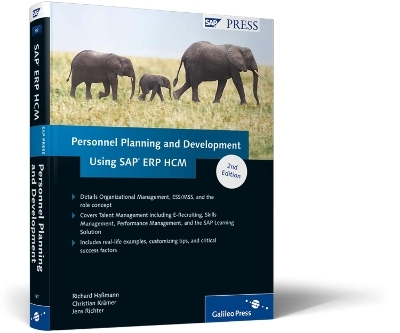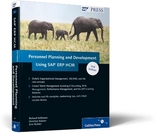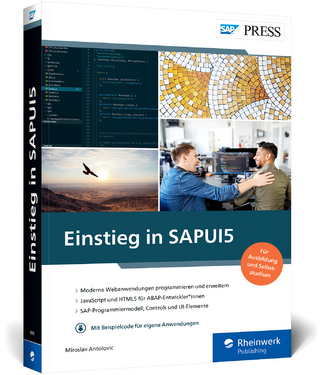Personnel Planning and Development Using SAP ERP HCM
SAP Press (Verlag)
978-1-59229-187-8 (ISBN)
- Titel ist leider vergriffen;
keine Neuauflage - Artikel merken
Richard Hassmann is the director of Hassmann-Consulting GmbH, a consulting firm that specializes in SAP ERP HCM within the AdManus Consulting Network. Richard Hassmann has more than 16 years of project experience with all modules of SAP ERP HCM. He implemented numerous requirements in the area of reporting in both national and international projects. In doing so, he used the standard tools of the SAP ERP system as well as those of SAP NetWeaver BI to implement numerous customerspecific reports and interfaces to many different external reporting tools. Christian Kramer has been working as department manager HR & Payroll Solutions for Media-Saturn IT Services GmbH (www.media-saturn.com) since mid-2008. Before this, he spent ten years working as a senior consultant, servicing customers in the field of SAP ERP HCM with a focus on E-Recruiting, Personnel Recruitment, Personnel Development, and Time Management. He has also carried out extensive projects on processoriented design for the implementation of SAP ERP HCM and gained experience in e-learning projects. Until mid-2008, he was a senior consultant at iProCon GmbH and a member of the AdManus management committee. Jens Richter is a graduate in business information systems and has worked as a consultant for iProCon GmbH (www.iprocon.de) since the end of 2006. He has served several clients in the field of SAP ERP HCM, focusing on Performance Management (MBO), E-Recruiting, Personnel Recruitment, and Personnel Development. Other areas of focus include ESS/MSS, Web Dynpro ABAP, and Workflow. Jens has also contributed to publications on the topic of Performance Management (MBO) in HR Expert.
Introduction 17
PART I Basic Principles 21
1 Overview of SAP ERP HCM 23
1.1 SAP ERP HCM as an Integrated Component of SAP ERP and the SAP Business Suite 23
1.2 SAP ERP HCM Components 25
1.3 Personnel Master Data 27
1.3.1 Basic Structure 28
1.3.2 Maintaining and Displaying Master Data 29
1.3.3 Integration into Personnel Planning and Development 33
1.4 Conclusion 34
2 Organizational Management 35
2.1 Business Foundations 35
2.2 The Process in SAP ERP HCM 36
2.2.1 Basic Terms 36
2.2.2 Selecting Object Types and Relationships 42
2.2.3 Status Administration 46
2.2.4 Evaluation Paths 47
2.2.5 Organizational Structure 48
2.2.6 Task Catalog 50
2.2.7 Maintenance Interface 53
2.2.8 Organizational Management as a Basis for Planning and Development 61
2.2.9 Organizational Management as the Basis for Personnel Administration 63
2.3 Implementation in SAP ERP HCM 66
2.3.1 Maintaining the Organizational Structure 66
2.3.2 Maintaining Structures 75
2.3.3 Maintaining the Matrix Organization 77
2.3.4 Selected Infotypes 80
2.3.5 Creating Individual Evaluation Paths 82
2.3.6 Creating Object Types 83
2.3.7 Expanding and Creating Infotypes 90
2.3.8 Adjusting the Maintenance Interface 93
2.3.9 Working with Different Plan Versions 98
2.3.10 Reports in Organizational Management 100
2.3.11 Transporting Structures 105
2.4 Process Examples 106
2.4.1 Creating New Positions with the Application Process 106
2.4.2 Scenario Planning 108
2.5 Critical Success Factors 110
3 Role Concept in SAP ERP HCM 111
3.1 Meaning of the Role Concept 111
3.2 Implementation of the Role Concept 112
3.2.1 Definition of Roles in the System 112
3.2.2 Assignment of Roles in the System 115
3.2.3 Connection between Role and User 117
3.3 Authorizations in SAP ERP HCM 118
3.3.1 Central Authorization Objects 119
3.3.2 Structural Authorization Check 123
3.3.3 Special Concepts in HCM Authorization 129
3.3.4 Context-Dependent Authorization Check 135
3.4 Critical Success Factors 137
4 SAP NetWeaver Portal in SAP ERP HCM 139
4.1 Basic Principles of SAP NetWeaver Portal 140
4.1.1 User Management 140
4.1.2 Components of Portal Applications 141
4.2 Business Packages in SAP ERP HCM 142
4.2.1 Employee Self-Services (ESS) 143
4.2.2 Manager Self-Services (MSS) 144
4.3 Reporting in the Portal 144
4.4 Conclusion 145
5 SAP Business Workflow 147
5.1 Features and Interactions 147
5.2 Integrating Workflows in SAP ERP HCM 148
5.3 Workflow Builder 149
5.4 Default Elements in Personnel Planning and Development 151
5.5 Processor Search 152
5.6 Critical Success Factors 152
6 Queries in SAP ERP HCM 155
6.1 Introduction 155
6.1.1 Structure and Technology of Queries 155
6.1.2 Logical Databases in SAP ERP HCM 157
6.2 Implementation in SAP ERP HCM 158
6.2.1 Use and Deployment Areas of Query in Personnel Planning and Development 158
6.2.2 Using SAP Query 159
6.2.3 Ad-hoc Query 161
6.2.4 Ad-hoc Query vs. SAP Query 163
6.3 Critical Success Factors 163
PART II Talent Management 165
7 Introduction to Talent Management 167
7.1 What is Talent Management 167
7.1.1 Defining the Target Groups 167
7.1.2 Areas of Talent Management 168
7.1.3 Design Framework of Talent Management 168
7.2 Talent Management in SAP ERP HCM 169
7.2.1 Parts 170
7.2.2 Enhanced Job Architecture 173
7.2.3 Infotypes 174
7.2.4 Prerequisites for Usage 175
7.3 Conclusion 176
8 Skill Management 177
8.1 The Process in SAP ERP HCM 177
8.1.1 Qualifications Catalog 177
8.1.2 Profiles 181
8.1.3 Reports 183
8.1.4 Integration 184
8.2 Implementation in SAP ERP HCM 186
8.2.1 Basic System Settings 186
8.2.2 Maintenance of the Qualifications Catalog 190
8.2.3 Working with Profiles 194
8.2.4 Central Control 200
8.3 Decentralized Skill Maintenance Sample Process 202
8.4 Critical Success Factors 203
9 Appraisal and Objectives 207
9.1 The Process in SAP ERP HCM 207
9.1.1 Functional Scope 207
9.1.2 Appraisal and Objective Setting Process 208
9.1.3 Integration 213
9.2 Implementation in SAP ERP HCM 215
9.2.1 Basic Customizing Settings 215
9.2.2 Customizing in the Catalog for Appraisal Templates 217
9.2.3 Business Server Pages 237
9.2.4 Creating Appraisal and Objective Settings 239
9.2.5 Reporting 242
9.3 Innovations in Enhancement Package 4 246
9.3.1 New User Interface with Web Dynpro ABAP 247
9.3.2 Cascading Goals 248
9.3.3 Team Calibration and Compensation 249
9.3.4 Integration with SAP Enterprise Learning 251
9.4 Critical Success Factors 252
10 Training and Event Management and SAP Learning Solution 255
10.1 Business Foundations 255
10.1.1 Forms of E-Learning 256
10.1.2 When Can E-Learning Be Used Effectively 257
10.1.3 Advantages of E-Learning 260
10.1.4 The Strategic Importance of E-Learning 261
10.2 Learning Management Systems 262
10.3 Design of Training and Event Management in SAP ERP HCM 263
10.3.1 Training and Event Management Structure 264
10.3.2 Dynamic Menus 267
10.3.3 Integration of Training and Event Management 272
10.4 Implementation in SAP ERP HCM 288
10.4.1 Setting Up the Training Catalog 288
10.4.2 Planning in Training and Event Management 302
10.4.3 Daily Activities 311
10.4.4 Follow-Up Processing of Courses 322
10.4.5 ESS in Training and Event Management 326
10.5 Sample Process: Paperless Training and Event Management 326
10.6 Critical Success Factors 329
10.7 SAP Learning Solution 329
10.7.1 The SAP Research Project in the Area of Learning 329
10.7.2 Features of the Service 330
10.7.3 Integration of SAP Learning Solution with SAP ERP HCM 338
10.7.4 Innovations in Enhancement Package 4 342
10.7.5 Sample Processes for E-Learning 348
10.7.6 Project Development 360
10.7.7 Critical Success Factors 362
11 SAP E-Recruiting 365
11.1 Business Principles 365
11.1.1 Goals of the Recruitment Process 365
11.1.2 Goals of Succession Planning 366
11.1.3 Recruitment Media 366
11.1.4 Managing the Application Process 369
11.1.5 Applicant Selection 371
11.1.6 Recruitment Controlling 372
11.1.7 Internet Recruiting 373
11.2 Specific Features of E-Recruiting 374
11.2.1 War for Talent 375
11.2.2 Sourcing and Retention 375
11.2.3 Controlling Recruitment Processes 376
11.2.4 Processes and Organization 376
11.2.5 Recruitment Service Providing 377
11.2.6 Technology 377
11.3 The Process of Recruitment in SAP ERP HCM 378
11.3.1 Overview 378
11.3.2 Processes and Roles of Recruiting 380
11.3.3 Requisitions 382
11.3.4 Process Templates 386
11.3.5 Questionnaires 388
11.3.6 Additional Important Terms 394
11.4 The Process of Succession Planning in SAP ERP HCM 396
11.4.1 Overview 396
11.4.2 Processes and Roles of Succession Planning 397
11.5 Roles in SAP E-Recruiting 402
11.5.1 The External Candidate 402
11.5.2 The Internal Candidate 414
11.5.3 The Manager 414
11.5.4 The Recruiter 416
11.5.5 The Administrator 420
11.5.6 Succession Planner 421
11.6 Customizing and Technology 422
11.6.1 Technical Settings 422
11.6.2 Basic Settings 422
11.6.3 Talent Warehouse 423
11.6.4 Applicant Tracking 424
11.6.5 Activities 425
11.6.6 Questionnaires 427
11.6.7 Requisition Management 427
11.6.8 Additional Technical Issues 427
11.7 Additional Innovations in Enhancement Package 4 428
11.8 Critical Success Factors 428
12 Enterprise Compensation Management 431
12.1 Overview 431
12.1.1 Options of Enterprise Compensation Management 431
12.1.2 Integration 432
12.2 Compensation Administration 432
12.3 Long-Term Incentives 434
12.4 Budgeting 435
12.5 Job Pricing 436
12.6 Conclusion 437
PART III Personnel Planning and Analytics 439
13 Personnel Planning Process 441
13.1 An Approach to Integrated Personnel Planning 441
13.1.1 Elements of Personnel Planning 442
13.1.2 Dividing Tasks Between Central and Local Planning Steps 445
13.1.3 Integrating Central and Local Planning Steps 447
13.1.4 Local Tasks 447
13.1.5 Central Tasks 448
13.2 An Overview of the Personnel Planning Process 448
13.2.1 Basic Principles of Personnel Planning 448
13.2.2 Personnel Planning Process Outline 449
13.2.3 Risk Management 450
13.3 Conclusion 451
13.3.1 Role-Specific Access 451
13.3.2 Content Requirements 451
14 Position and Quota Planning 453
14.1 The Process in SAP ERP HCM 453
14.1.1 Planning at Position Level 453
14.1.2 Quota planning 456
14.1.3 Openness for Enhancement and New Structures 457
14.2 Implementation in SAP ERP HCM 457
14.2.1 Relevant Infotypes 457
14.2.2 Reports Based on Positions 460
14.2.3 Quota Planning 462
14.3 Process Examples 463
14.3.1 Risk Management 463
14.3.2 Structuring the Job Index 464
14.4 Critical Success Factors 465
15 Personnel Cost Planning and Simulation 467
15.1 Integration with Other Components 468
15.2 Processes of Personnel Cost Planning 469
15.3 Planning Preparation 470
15.3.1 Defining a Planning Context 471
15.3.2 Defining a Planning Scenario 471
15.3.3 Defining Cost Items 472
15.4 Data Collection 472
15.4.1 Technical Correlation of Wage Type, Symbolic Account, and Cost Item 472
15.4.2 Data Collection for Employees 474
15.4.3 Defining Your Own Data Collection Methods 476
15.4.4 Example of a Data Collection 477
15.4.5 Data Collection for Organizational Objects 478
15.4.6 Follow-Up Processing of Collected Data 479
15.5 Creating and Managing Personnel Cost Plans 480
15.5.1 Executing a Planning Run 480
15.5.2 Customizing of the Planning Run 482
15.6 Planning by the Person Responsible for Costs 483
15.7 Planning by the Cost Planner 484
15.8 Transferring the Cost Plan to Controlling 484
15.9 Reporting 485
15.9.1 Reporting in SAP ERP HCM 485
15.9.2 Reporting in SAP NetWeaver BW 486
15.10 Available Standard Roles for Cost Planning 488
15.11 BAdIs in Cost Planning 488
15.11.1 BAdIs in Data Collection 488
15.11.2 BAdIs in the Cost Planning Run 488
15.11.3 BAdI in Detail Planning 489
15.11.4 BAdI for Posting to Accounting 489
15.12 Critical Success Factors 489
16 Analysis of Personnel Planning and Development Using SAP NetWeaver BW 491
16.1 Introduction to SAP NetWeaver BW 491
16.2 Creating Evaluations with the BEx Query Designer 494
16.3 Reporting Using the BEx Analyzer 499
16.4 Reporting in the Portal Using the BEx Web Analyzer 502
16.5 BEx Web Application Designer 503
16.6 Business Content 504
16.6.1 Strategic Personnel Management 505
16.6.2 Organizational Management 505
16.6.3 Personnel Development 506
16.6.4 Personnel Cost Planning 506
16.6.5 Training and Event Management and SAP Learning Solution 507
16.6.6 Performance Management 507
16.6.7 Enterprise Compensation Management 508
16.6.8 Talent Management 510
16.6.9 E-Recruiting 511
16.7 Conclusion 512
17 SAP Strategic Enterprise Management 513
17.1 Basic Principles 513
17.1.1 Business Foundations 513
17.1.2 Problem Areas 514
17.2 SAP SEM System Modules 514
17.2.1 Business Planning and Simulation (SEM-BPS) 515
17.2.2 Business Consolidation (SEM-BCS) 515
17.2.3 Strategy Management (SEM-SM) 515
17.2.4 Performance Measurement (SEM-PM) 516
17.2.5 Stakeholder Relationship Management (SEM-SRM) 517
17.3 Relevance to Personnel Management 517
17.4 Conclusion 517
Appendices 519
A Infotypes in Personnel Planning and Development 521
B Reports in Organizational Management 537
C Authorization Objects 541
D BAdIs in the Appraisal and Objectives Component 543
E xplanations for Process Models 545
F Recommended Reading 549
G The Authors 551
Index 553
| Erscheint lt. Verlag | 30.1.2010 |
|---|---|
| Reihe/Serie | SAP Press |
| Verlagsort | Maryland |
| Sprache | englisch |
| Maße | 175 x 228 mm |
| Einbandart | gebunden |
| Themenwelt | Mathematik / Informatik ► Informatik ► Netzwerke |
| Informatik ► Weitere Themen ► SAP | |
| ISBN-10 | 1-59229-187-2 / 1592291872 |
| ISBN-13 | 978-1-59229-187-8 / 9781592291878 |
| Zustand | Neuware |
| Informationen gemäß Produktsicherheitsverordnung (GPSR) | |
| Haben Sie eine Frage zum Produkt? |
aus dem Bereich




